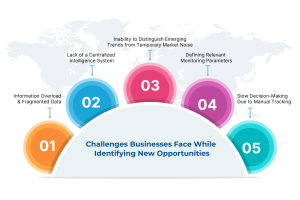Navigating market opportunities requires more than just intuition, it demands a structured approach backed by data. Businesses operate in an environment shaped by economic shifts, competitive movements, and changing customer needs. Understanding these factors is essential for making informed decisions.
Market and competitive intelligence (M&CI) provides the insights needed to evaluate trends, assess competition, and identify gaps in the market. With a clear view of your company’s strengths and the industry landscape, you can uncover opportunities that align with your business goals.
This guide explores common business challenges while identifying new opportunities and how M&CI can help you rise above them.
Challenges Faced by Businesses in Identifying New Opportunities
While businesses recognize the need to capture market opportunities, they often struggle due to the following challenges:
1. Information Overload & Fragmented Data
With the world generating more than 400 million terabytes of information daily, the available market data has become overwhelming. Businesses must sift through many sources extensively to find the information they need.
For instance, industry reports, competitor updates, news articles, regulatory changes, consumer trends, and social media are just a few examples, yet staying on top of them all is still a challenge. Without a structured approach, companies risk drowning in data without extracting meaningful insights.
2. Lack of a Centralized Intelligence System
Many companies rely on disparate data sources that are not integrated with their systems.
This leaves the relevant stakeholders with fragmented insights, making it tougher to develop a comprehensive strategy.
Without a single source of truth, important updates get missed, and market opportunities remain undiscovered.
3. Defining Relevant Monitoring Parameters
Businesses often struggle to define what information is truly relevant to their growth. For example:
- A company expanding into a new market must decide which local competitors, regulations, and consumer trends to track.
- A manufacturing firm looking for partnership opportunities needs to identify the right industry events and M&A activities.
Without clear parameters, businesses either gather too much irrelevant data or miss critical insights.
4. Slow Decision-Making Due to Manual Tracking
Manually researching market trends, competitor activities, and regulatory changes is a time-consuming and inefficient process. By the time you gather relevant insights, the opportunity may no longer be viable.
Companies relying on outdated tracking methods find it difficult to respond in real time to market shifts, giving competitors the upper hand.
5. Inability to Distinguish Emerging Trends from Temporary Market Noise
With the popularity of social media, market trends tend to be heavily influenced and passing. Businesses need to gauge which market trends are actual opportunities, as opposed to passing trends.

For example:
- A new product launch by a competitor might create buzz, but will it disrupt the industry?
- A regulatory shift might affect operations, but will it open new revenue streams?
These are just a few examples of what brands should consider before investing their resources in passing trends that may not even last a week or garner the attention they desire.
Key Steps to Identifying and Capturing Market Opportunities
Businesses can overcome these challenges by implementing a structured approach to market intelligence. Here’s how:
1. Define Your Market Intelligence Goals
Before diving into data collection, establish clear objectives to guide you through. Some common goals include:
- Identifying new geographies or industries for expansion
- Tracking regulatory shifts that could impact business operations
- Understanding competitor product strategies and pricing models
- Finding gaps in the market where customer needs are unmet
A well-defined goal ensures that intelligence efforts remain focused and actionable.
2. Gather Data from Diverse and Reliable Sources
A comprehensive intelligence strategy requires gathering insights from multiple sources, including:
- Industry Reports & Analyst Insights – Understanding macroeconomic trends and technological advancements.
- Competitor Tracking – Monitoring product launches, marketing campaigns, and strategic partnerships.
- Regulatory & Policy Changes – Identifying compliance updates that may create new business opportunities.
- Consumer Sentiment & Market Demand – Using social media, customer reviews, and surveys to track evolving preferences.
Utilizing AI-driven intelligence platforms can automate this process, ensuring businesses stay in the know without manual effort.
3. Filter and Categorize Data for Relevance
With vast amounts of data available, businesses must apply advanced filtering techniques to extract meaningful insights. Key strategies include:
- Keyword Optimization – Tracking relevant industry terms, product categories, and competitor mentions.
- Taxonomy-Based Categorization – Structuring data into relevant categories such as regulatory changes, funding news, and product developments.
- Noise Reduction – Eliminating duplicate or low-value data points to focus on actionable intelligence.
Such effective filtering techniques ensure decision-makers receive only the most critical insights rather than an overwhelming volume of raw data.
4. Analyze Trends to Identify Gaps in the Market
Once relevant data is collected, businesses must analyze trends to identify market gaps. This includes:
- Competitive Benchmarking – Comparing pricing, distribution channels, and marketing strategies with competitors.
- Trend Forecasting – Using historical data to predict future shifts in customer demand.
- Regulatory Impact Assessment – Evaluating how policy changes may open up new business avenues.
By connecting these insights, businesses can pinpoint untapped opportunities and move proactively.
5. Take Swift Action Based on Intelligence Insights
Having market intelligence is only valuable if businesses act on it. This involves:
- Adapting Business Strategies – Tweaking product offerings, pricing, or market positioning based on insights.
- Targeted Marketing and Sales Initiatives – Engaging potential customers or partners in high-growth areas.
- Exploring New Partnerships and Investments – Identifying acquisition targets, joint ventures, or supply chain improvements.
Market and competitive intelligence (M&CI) platforms like Contify that allow you to create intelligence alerts ensure that decision-makers can react quickly to market shifts.
Real-World Examples of Organizations Leveraging M&CI to Track New Opportunities
 Listed below are some real-world examples of Contify empowering organizations to identify and grab market opportunities.
Listed below are some real-world examples of Contify empowering organizations to identify and grab market opportunities.
A Food Ingredient Manufacturer Expands Market Reach for Sugar Alternative
A company specializing in a rare sugar alternative sought to educate the market about its benefits and expand into new geographies and customer segments. However, they faced multiple hurdles:
- Information Overload: Struggled to track relevant updates across multiple sources.
- Fragmented Market Intelligence: Regulatory changes and partnerships were difficult to monitor.
- Low Market Awareness: Needed to increase awareness of their product’s benefits and its potential as a sugar substitute.
- Engagement & Demand Generation: Difficulty in maintaining consumer interest and converting attention into demand.
With the help of Contify’s automated news tracking, competitor benchmarking, and near-real-time insights, the company successfully identified new high-growth markets for its product. They also successfully optimized its outreach strategy and built stronger engagement with potential customers and partners.
A Singapore-Based Business Tracks Innovation and Funding Opportunities
A company focused on tracking startup innovation and funding opportunities in Singapore needed better visibility into their mentions and government-backed innovation programs, real-time funding insights, and global and local startup trends impacting the Singaporean business ecosystem.
Their biggest obstacles included:
- Data Overload: Managing vast amounts of information while ensuring relevance.
- Defining Key Monitoring Parameters: Filtering updates specific to Singapore’s business landscape.
- Keyword Ambiguity: Preventing irrelevant content from appearing in intelligence reports.
Contify helped them deploy a market intelligence solution to track government initiatives and funding programs in near-real time, monitor local and global startup trends for actionable investment opportunities.
Further, AI-driven filtering helped eliminate noise and focus on meaningful updates, and automate industry reports to ensure timely insights for decision-makers.
Conclusion
Identifying and capturing market opportunities is no longer just about intuition; it requires a structured approach driven by Market and Competitive Intelligence. By implementing AI-powered intelligence platforms, businesses can overcome data challenges, gain real-time insights, and seize new opportunities with confidence.
A well-executed M&CI strategy ensures that companies remain competitive, agile, and prepared for future market shifts. Get in touch with us today to explore greater business possibilities.



